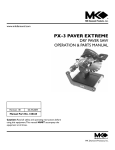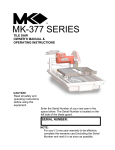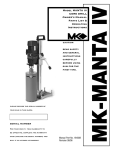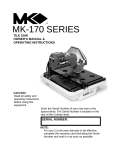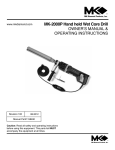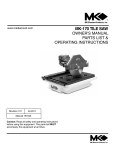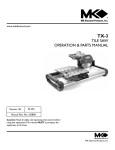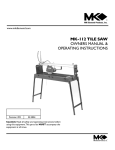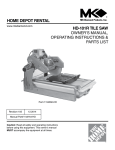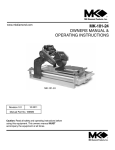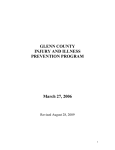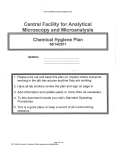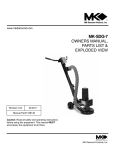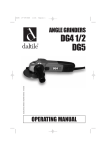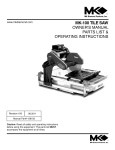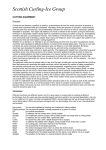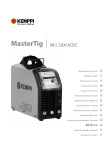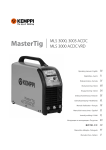Download to the Fire Tiger Tooth Blade Safety Instruction Manual.
Transcript
www.mkdiamond.com Fire Tiger Tooth Blade Safety INSTRUCTION MANUAL Revision 101 04.2011 Manual Part# 167956 Caution: Read all safety and operating instructions before using this equipment. MK Diamond Products, Inc. INTRODUCTION This manual contains the safety precautions and recommended cutting techniques for using the Fire Tiger Tooth Diamond Blade with a gasoline-powered cut-off saw. It is important that you read, fully understand and observe the following safety precautions and warnings when using the Fire Tiger Tooth blade on a cut-off saw. Failure to read and follow these instructions could result in injury or death to you or others. Failure to read and follow these instructions could also result in damage and/or reduced equipment life. Gasoline-powered cut off saws are all very similar in the way they perform, however they may have different parts and controls. You should therefore always refer to the instruction manual for your particular cut-off saw prior to use. If you do not understand any of the instruction in the manual, please contact the manufacturer for clarification. The use of any cut-off saw may be hazardous. Because a cut-off saw is a high-speed, fast cutting power tool, special safety precautions must be observed to reduce risk of personal injury and fire. Before using this equipment ensure the person operating the machine has read and understands all instructions in this manual. WARNING Careless or improper use of any cut-off saw may cause serious or fatal injury. DANGER Failure to follow these instructions could result in serious or fatal injury. Do not operate this equipment before reading this entire manual. 2 TABLE OF CONTENTS Introduction 2 Blade Description and Precautions 4 Operator Safety Preparation Training Safety 5 5 5-6 Preflight Transporting the Saw Before You Start Your Cut 7 7 Working Techniques Blade Inspection Saw Adjustments Blade Installation Starting the Saw Using the Saw 8 8 9 9 10 Troubleshooting Blades Inspection & Storage 12 13 3 BLADE DESCRIPTION & SAFETY PRECAUTIONS The Fire Tiger Tooth multi-purpose blade uses the latest MK Vacuum Brazed technology that addresses the needs of fire fighter, rescue, Urban Search And Rescue and police. With the Fire Tiger Tooth blade a diverse range of materials can be cut such as masonry, concrete, roof tile, dry wall, stainless steel, wood, steel, plastic, stucco, PVC, copper pipe, corrugated roofing, aluminum and polyethylene pipes. The Vacuum Brazed Technology gives the blade longevity when used on a variety of materials. The type of material being cut and the condition of the blade predicates blade life. Due to the construction of a vacuumed brazed blade it does not need an abrasive factor to wear away the metallurgical matrix. Man-made industrial diamonds are vacuumed brazed directly onto a heat treated steel core. SAFETY MESSAGE / ALERT Read and follow all safety, operating and maintenance instructions. Failure to read and follow these instructions could result in injury or death to you or others. Failure to read and follow these instructions could also result in damage and/or reduced equipment life. SAFETY MESSAGES A safety message alerts you to potential hazards that could hurt you or others. Each safety message is preceded by a safety alert symbol ( ) and one of three words: DANGER, WARNING, or CAUTION. DANGER You WILL be KILLED or SERIOUSLY INJURED if you do not follow directions. WARNING You CAN be KILLED or SERIOUSLY INJURED if you do not follow directions. CAUTION You CAN be INJURED if you do not follow directions. It may also be used to alert against unsafe practices. SILICA DUST WARNING Grinding/cutting/drilling of masonry, concrete, metal and other materials with silica in their composition may give off dust or mists containing crystalline silica. Silica is a basic component of sand, quartz, brick clay, granite and numerous other minerals and rocks. Repeated and/or substantial inhalation of airborne crystalline silica can cause serious or fatal respiratory diseases, including silicosis. In addition, California and some other authorities have listed respirable crystalline silica as a substance known to cause cancer. When cutting such materials, always follow respiratory precautions. CALIFORNIA PROPOSITION 65 MESSAGE Some dust created by power sanding, sawing, grinding, drilling, and other construction activities contain chemicals known (to the State of California) to cause cancer, birth defects or other reproductive harm. Some examples of these chemicals are: • Lead, from lead-based paints • Crystalline silica, from bricks and cement and other masonry products • Arsenic and chromium, from chemically treated lumber CALIFORNIA DEPARTMENT OF INDUSTRIAL RELATIONS: §1503.1 control of employee exposures from dust-generating operations conducted on concrete or masonry. Your risk from these exposures varies depending on how often you do this type of work. To reduce your exposure to these chemicals or materials, work in a well-ventilated area, and work with approved safety equipment, such as those dust masks that are specially designed to filter out microscopic particles. For further information, consult the following sources: http://www.osha.gov/SLTC/silicacrystalline/index.html http://www.oehha.org/prop65/out_of_date/6022kLstA.html www.dir.ca.gov/Title8/1503_1.html 4 OPERATOR SAFETY Preparation You must be in good physical condition and mental health and not under the influence of any substance (drugs, alcohol, etc) that might impair vision, dexterity or judgment. Do not operate a cut-off saw when you are fatigued. Be alert - if you are tired while operating a cut-off saw you could lose control of the saw or situational awareness of the area around you during cutting. TRAINING A first time operator should obtain practical instruction before using the cut-off saw from a certified operator using an established training program that assures safe operations and understanding of the cut-off saw and Fire Tiger Tooth Blade. Be sure that anyone using the Fire Tiger Tooth with a cut-off saw understands the information contained in this instruction manual. Even if you are an experienced user of gasoline-powered cut off saws, it is in your best interest to familiarize yourself with these instructions and safety precautions. Read the cut-off saw and Fire Tiger Tooth instruction manual and the safety precautions periodically. SAFETY Read the instruction manual and the safety precautions periodically. In order to reduce the risk of injury to the operator, Personal Protective Equipment (PPE) should be used at all times when operating a gas-powered cut-off saw. Clothing includes helmet, gloves, boots and eye and ear protection and must be sturdy and snug fitting. Heavy-duty non-slip gloves improve your grip and help to protect your hands. Good footing (position) is very important when using a cut-off saw. Wear only sturdy boots with non-slip soles. Steel toed safety boots are recommended. Loose objects may be thrown toward the operator by the blade during cutting. To reduce the risk of injury to your eyes never operate a cut-off saw unless wearing goggles or properly fitted safety glasses with adequate top and side protection complying with ANSI Z87.1. Always wear sound barriers (ear plugs or ear mufflers) to prevent hearing loss. When wet cutting is not utilized, the operator should always wear a respirator approved by NIOSH/MSHA for the material being cut to reduce the risk of serious or fatal respiratory illness. 5 OPERATOR SAFETY WARNING Operate the cut-off saw under good visibility. WARNING Wearing of hearing protection reduces sound perception. Be alert not to miss voice signals from coworkers. Keep within calling distance of other persons who may assist in case of emergency. WARNING The area should be clear of all obstacles. Be extremely cautious when working on slopes or uneven ground. WARNING Cutting metal will produce sparks that can burn or cause clothing to catch fire. Always direct sparks away from the operator or any flammable surroundings. Never cut metal while standing on a flammable surface, such as wood or tarpaper. Where there is the risk of fire, have the appropriate fire extinguishing equipment readily available. In order to reduce the risk of burn injury the wearing of clothing made of flame retardant clothing is recommended CAUTION Prolonged cutting will expose the operator to vibrations that may produce White Finger Disease (Reynard’s Phenomenon) or Carpal Tunnel Syndrome. These conditions will reduce the hand’s ability to feel and regulate temperature, produce numbness and burning sensations and could cause nerve damage and tissue necrosis. In order to reduce the risk of developing White Finger Disease and or Carpal Tunnel Syndrome please note the following: • Wear gloves and keep your hands warm • Use a saw that has an anti-vibration system • Maintain a firm grip at all times, but do not squeeze the handles with a constant, excessive pressure. WARNING Use of this blade to cut masonry, concrete, metal and other materials can generate dust and fumes containing chemicals known to cause serious or fatal injury or illness, such as respiratory disease, cancer, birth defects or other reproductive harm. WARNING Never let the cut-off saw run unattended. WARNING Never modify the cut-off saw in any way. WARNING The cut-off saw is a one-person tool. Do not allow others to be near the saw during operation. 6 PREFLIGHT Transporting the Saw Cutting Plane Always stop the engine before putting the saw down, carrying it or rotating the saw outside of the cutting plane. After turning off the engine the blade will continue to rotate for a short while after the throttle trigger is released (flywheel effect). 10° Carrying the cut-off saw with the engine running is extremely dangerous. If the blade is rotating it can cause accidental acceleration of the engine. When carrying your cut-off machine by hand, the engine must be stopped and the cut-off machine must be in the proper position. Grip the front handle and place the muffler at the side away from the body. Cut Area Cut Area WARNING Always protect the blade from hitting the ground or any other objects. Damaged blades may shatter and cause serious or fatal injury. Before You Start Your Cut WARNING Never cut into a pipe, drum or other container without first ensuring that it does not contain a volatile or flammable substance. When cutting into existing walls, floors or similar structures, be alert for hidden hazards such as electrical cables, water and gas pipes and flammable substances. Make sure that power, water and gas have been shut off and pipes drained before starting to cut. Cutting metal will produce sparks that can burn or cause clothing to catch fire. Always direct sparks away from the operator or any flammable surroundings. Never cut metal while standing on a flammable surface, such as wood or tarpaper or in an area containing flammable liquids. Where there is the risk of fire, have the appropriate fire extinguishing equipment readily available. The cutting sequence is important when cutting openings and recesses, etc. The last cut must always10°be made in such a way that the blade cannot become bound and so that the user is not at risk of being injured due to kick back of the saw by the blade being pinched. 10° A number of points must be decided before making the cut: • How heavy is the part? • In which direction can it move after being severed? • Is the material under tension? • What is the proper position of the operator in relationship to the cut? CAUTION Cut Area Incorrect Method Cut Area Cut Area Correct Method 7 Always cut from the outside perimeter of the area being cut. Working Techniques BLADE INSPECTION Only use the approved blade for the type of material to be cut. Before mounting the cutting blade, make sure that the maximum operating speed of the blade is above or equal to the spindle speed of the cut-off saw. A blade used at a higher speed than that approved may shatter or break and poses a threat of serious or fatal injury to the operator and other nearby persons. Blade Diameter Maximum Safe Speed/RPM 12" 6,300 14" 5,460 16" 4,725 Always inspect the blade prior to mounting or use and replace immediately if the blade shows any signs of cracks or is warped. Cracked or warped blades may shatter or break and cause serious or fatal personal injury. Out-of-round or unbalanced blades increase vibration and can also develop excessive heat build up during cutting. Refer to page 12 for details The Fire Tiger Tooth blade is a “bi-directional” blade and can be used rotating in either direction. Most other blades are designed to be operated in only one direction and must always be mounted so that the arrow on the blade points in the direction of rotation of the spindle. WARNING Do not remount a used blade without first inspecting for cracks, flatness, core fatigue, segment damage or loss, signs of overheating (discoloration) and/or arbor hole damage. WARNING Circular saw blades, carbide tipped blades, diamond blades, rescue blades, and woodcutting blades can cause severe personal injury from blade contact. These blades are susceptible to throwing objects and/or reactive forces. WARNING Use of the wrong blade for the cutting of material for which the blade was not designed may cause the blade to fail, causing serious or fatal injury. Saw Adjustments The blade guard on most cut-off saws will rotate. It is extremely important that the blade guard always be adjusted to the type of work prior to cutting so that the user is not endangered by particles of the material being cut, sparks, or pieces of damaged blades either directly or by ricochet. 8 Working Techniques Blade Installation Remove retaining screw and outer flange using a wrench. Install the blade onto the blade shaft. Verify the blade is seated on the blade shaft. Install the retaining screw and outter flange and then tighten with wrench. Starting the Saw Always place the cut-off saw on firm ground or a solid surface in an open area. Maintain good balance and secure footing. Be absolutely sure that the blade is clear of you and all other obstructions and objects, including the ground. Wrap your fingers tightly around the handle, keeping the handle cradled between your thumbs and forefingers. Make sure that grips are in good condition and free of moisture, pitch, oil or grease. When you pull the starter grip handle, don’t wrap the starter rope around your hand. Do not allow the starter grip to snap back, guide the starter rope slowly back to permit the rope to rewind properly. Do not drop start the cut-off saw. This method is very dangerous because the operator may lose control of the cut-off saw. Once the engine has been started always hold the cut-off saw firmly with both hands. Place your left hand on the front handle bar and your right hand on the trigger. (Left hand users should follow this instruction for maximum control.) note: At correct idle speed, the blade should not turn. Do not use a cut-off saw with the incorrect idle speed adjustment. A spinning blade may cause injury. Never attempt to start the cut off saw when the blade is in the cut. Never operate the cut-off saw with the starting-throttle lock engaged as this does not permit proper control of the speed of the unit and may lead to serious injury. When the engine starts the speed will be fast enough for the clutch to engage the v-belt pulley and turn the blade. Once the engine has started, immediately disengage the throttle trigger, which should release the starting throttle and allow the engine to slow down to an idle, preventing the blade from turning. note: Read saw operating manual for complete starting procedures. WARNING Failure to follow these procedures may result in injuries to your hands and fingers and may cause damage to the starter mechanism. WARNING Gas engine exhaust contains poisonous carbon monoxide. Avoid inhaling exhaust fumes and never run the engine in a closed building or confined area. 9 Working Techniques Using the Saw To achieve a clean and efficient (safe) cut, pull the blade across the material or move it back and forth in the cutting direction. Do not force the blade into the material. Thick-walled work pieces should be cut with a swinging movement, back and forth. Allow the wheel to cool by releasing pressure and freewheeling the blade by pulling the blade out of the cut every 60-90 seconds and running it for 10-15 seconds. Insert the blade into the material only as deep as necessary to make the cut. To reduce the amount of dust created, do not cut all the way through the material; leave a thin piece uncut. For most materials, this piece can be easily broken afterwards. Keep the blade 90° to the cut to prevent it from being cocked, jammed or wedged in the material. Always stop the cut-off saw and be sure that the blade has stopped spinning before setting the cut-off saw down. To reduce the risk of serious or fatal injury, do not change the direction of the cut during the cut as this may produce a high torsion load on the blade and may cause it to break, shatter or develop stress cracks. Lateral Pressure It is essential to determine the exact direction of the cut before applying the blade to the work/material. Blades are constructed for radial pressure only. Lateral pressure must be avoided. Hold the cut-off saw steady at all times. Re-entering an existing cut must be done slowly and carefully. Reactive Forces To reduce the risk of injury from shattered blades: • Do not exceed the maximum operating speed of the blade. • Do not use the blade if it has been dropped. • Do not cut any material for which the blade was not made to cut. • Do not grind on the side of the blade. • Do not twist, thrust, knock or drop the cut-off saw. An understanding of causes of reactive forces may help to avoid loss of control. Reactive forces are exerted in a direction opposite to the direction in which the blade is turning at the point of contact or pinch. Kickback Reactive forces may occur at any time during cutting. If the blade is slowed or stopped by frictional contact with any solid object or by a pinch, reactive forces may occur instantly and with great force. These reactive forces may result in the operator losing control of the saw, which may, in turn, result in serious or fatal injury. Pull-away n t er t p ran d Fr Qu Up o a Pull-away, climbing, pinching and rotational kickback forces. The most common reactive forces are pull-away and climbing. If the contact is at the bottom of the blade, a cut-off saw will try to pull away from the operator (pull-away). If the contact is at the front of the blade, the blade may attempt to climb the object being cut (climbing). Pinching occurs when the material being cut closes on the blade. If the blade is severely pinched at the front, especially in the forward upper quadrant, the blade may be instantly thrown up and back towards the operator with great force in a rotational kickback motion. 10 Working Techniques n t er t p ran d The greater the force generated, the more difficult it will be for the operator to control the cut-off saw. Any of the reactive Fr Qu Up o a forces can in some circumstances, cause the operator to lose control of the saw, allowing the spinning blade to come into contact with the operator. Severe personal injury or death can result. t on e r n t p ra d F Qu Up r a In order to reduce the risk of kickback injury, avoid cutting with the upper quadrant of the blade where possible. Be especially cautious for a pinching of the blade in this area, which can cause severe reactive forces in a rotational kickback motion. Be alert to potential movement of the material or anything else that could cause the cut to close and pinch the blade. In order to reduce the risk of pinching, support the material in such a way that the cut remains open during the cutting process and when the cut is finished. Never make a cut that results in a binding of the blade. Be particularly alert when cutting a work piece that, if not properly supported, can sag upon completion of the cut, creating a pinch not where you are actually cutting but rather, at or near the top of the work piece. If that pinch is in the upper quadrant of the blade kickback can result. WARNING • • • • • • In order to reduce risk of injury from the loss of control from reactive forces, including kickback: Hold the cut-off saw firmly with both hands Maintain good balance and footing at all times. Never cut while in an unstable position. Position the cut-off saw in such a way that your body is clear of the cutting action. Avoid standing in direct line with the blade. Never bend over the cut-off saw especially when the guard is pulled back towards the top and there is a risk of reactive forces. Do not cut above shoulder height. Begin cutting and continue at full throttle. Do not over reach. WARNING • • • • • Be especially alert for reactive forces, including kickback, when cutting with the front and upper quadrant of the blade. Be alert to shifting of the work piece or anything that could cause the cut to close and pinch the blade, especially in the upper q uadrant. Support the material in such a way that the cut remains open. Never make a cut that results in a binding of the blade. Release the pressure on the cut-off saw as you reach the end of the cut. Too much pressure may cause the operator to lose control of the cut-off saw when the blade completes the cut. The blade may contact the operator. When removing the blade out of the cut make sure the blade is rotating. Use extreme caution when reentering the cut and do not turn the blade at an angle or push the blade into the cut as this may result in a pinching of the blade. Allow the blade to find its own path into the existing cut. Gyroscopic Forces Be alert for gyroscopic forces that are caused by the rapid spinning of the blade. These forces result in opposition to directional change, e.g. when the operator attempts to move the saw in a sideways direction. 11 Troubleshooting Radial and Axial Run-out A Undercutting The spindle is critical to the essential operation of any blade. Using a blade with a worn out spindle can cause axial and radial run out. Excessive run-out causes the individual segments of a Tiger Tooth Blade to be overloaded and to over heat. This can in turn lead to stress cracking in the blade core or to weaken the laser weld. Axial run-out (A) or wobble (B) results in higher thermal stress and wider cuts. B Abrasion of steel center due to highly abrasive fines generated during cutting can cause undercutting (reduction of core thickness where it joins the blade segment). Immediately replace any blade if the steel core shows any signs of severe undercutting. Built-up Edges Built-up edges increase vibrations, reduce cutting performance and can cause excessive sparking. They can be identified by a pale grey deposit on the top of the segment that clogs and blunts the segments. Built-up edges can form: • When cutting extremely hard material. • As a result of incorrect handling such as applying excessive feed force. • If extremely large sections are cut without a pendulum movement (back and forth in the cutting plane). • As a result of cutting aluminium Segment Cracks Always check the blade after unintentionally striking any object; frequently check the blade during use after stopping. Look for cracks, and make sure that it is undamaged and in good condition and that no pieces have broken off. If the blade shows signs of excessive heat then remove the blade and inspect the steel core for crack. Blade should be removed from cut after one minute and allowed to cool (free wheeling) for 10 to 20 seconds. Diamond Lost Heat Build-Up The segment has lost all the diamond crystal, which if used will result in build up, which will result in cracks. If you continue to use a blade with blunt segments, this will result in excessive heat build up. The blade core will also over heat and lose its mechanical strength. This can lead to considerable stress, as clearly indicated by stress cracks and/or a wobbling movement of the blade. Such blade may break apart or throw off a segment or segments during use, causing serious or fatal injury. Replace immediately. 12 INSPECTION Blade Sharpening Like most cutting instruments, a diamond blade cuts best when it is sharp! When material being cut is matched with the proper diamond blade, it should yield swift and accurate cuts, and maintain an optimum operational life. No two materials cut alike. Occasions may arise where a percentage of the diamonds on the blade edge and periphery smooth “glaze” over and the cutting efficiency is reduced. Additionally, this condition may cause the blade to “wander” or bend in the cut, giving the illusion of an “out-of-alignment” condition. If you experience any lack of cutting efficiency or effectiveness, sharpen your diamond blade by making several cuts into a very abrasive material, such as simple cinder block or soft sandstone. Final Inspection The blade guard should be inspected daily for any signs of cracks or breaks. Any time a blade fails, the inside of the blade guard should be inspected immediately for any stress cracks before continuing. If damage is found replace the blade guard immediately. A blade guard should be replaced after three blade failures even if there are no visible signs of cracks or breaks. Always check the blade after each use, inspecting for stress cracks and broken segments. Either of these conditions warrants replacement of the blade prior to next use of the saw. Blade Storage Do not store the blade mounted on the cut-off saw. Store blades on a flat surface in a dry place. Failure to follow these directions for storage my cause the blade to shatter or crack in use causing serious or fatal injury. 13 notes 14 notes 15 Fire Tiger Tooth Safety Instruction Manual OWNERS MANUAL & OPERATING INSTRUCTIONS DOCUMENT NO. 167956 REVISION 100 09/09 MK Diamond Products, Inc. 1315 Storm Parkway Torrance, CA 90501 Toll-Free: (800) 845-3729 Phone: (310) 539-2221 Fax: (310) 539-5158 www.mkdiamond.com
















